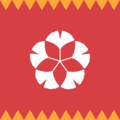Etzavazi semistics: Difference between revisions
(Created page with "The field of '''Etzavazi semistics''' studies the flags, banners, and standards of Etzavaz. The Etzavazi system of flags differs from those in other cultures; these are usually referred to as '''semeion'''. == Parts of a semeion == === Pole === A semeion is held up by a large, semi-flexible pole, usually made of teak wood. In modern times, aluminum is often used either as a core or...") |
No edit summary |
||
| Line 18: | Line 18: | ||
Minor banners are more free-form, although usually are longer than a major banner. They are often cut into [[wikipedia:Swallowtail_(flag)|swallowtail]] shapes or triangles. |
Minor banners are more free-form, although usually are longer than a major banner. They are often cut into [[wikipedia:Swallowtail_(flag)|swallowtail]] shapes or triangles. |
||
| + | |||
| + | [[Category:Etzavaz]] [[Category:Flags]] [[Category:South Etzavaz]] |
||
Latest revision as of 15:58, 8 April 2025
The field of Etzavazi semistics studies the flags, banners, and standards of Etzavaz. The Etzavazi system of flags differs from those in other cultures; these are usually referred to as semeion.
Parts of a semeion
Pole
A semeion is held up by a large, semi-flexible pole, usually made of teak wood. In modern times, aluminum is often used either as a core or replacing the wood entirely, creating a more durable but less flexible pole.
Major banner
The major banner is usually a large square, ranging from 2 to 5 meters in each direction. This banner usually indicates the ruling family of a clan. In military use, this is often either the banner of the royal family, or of the particular general of a regiment. The major banner is almost always at the top of the semeion, although a minor banner may sit above it in order to denote subservience to another semeion.
-
Major banner of Chyšyla
Minor banners
Minor banners are more free-form, although usually are longer than a major banner. They are often cut into swallowtail shapes or triangles.
